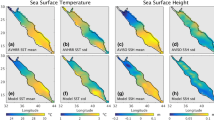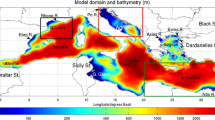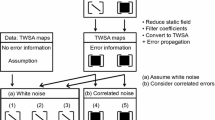Abstract
Forecasting the state of large marine ecosystems is important for many economic and public health applications. However, advanced three-dimensional (3D) ecosystem models, such as the European Regional Seas Ecosystem Model (ERSEM), are computationally expensive, especially when implemented within an ensemble data assimilation system requiring several parallel integrations. As an alternative to 3D ecological forecasting systems, we propose to implement a set of regional one-dimensional (1D) water-column ecological models that run at a fraction of the computational cost. The 1D model domains are determined using a Gaussian mixture model (GMM)-based clustering method and satellite chlorophyll-a (Chl-a) data. Regionally averaged Chl-a data is assimilated into the 1D models using the singular evolutive interpolated Kalman (SEIK) filter. To laterally exchange information between subregions and improve the forecasting skills, we introduce a new correction step to the assimilation scheme, in which we assimilate a statistical forecast of future Chl-a observations based on information from neighbouring regions. We apply this approach to the Red Sea and show that the assimilative 1D ecological models can forecast surface Chl-a concentration with high accuracy. The statistical assimilation step further improves the forecasting skill by as much as 50%. This general approach of clustering large marine areas and running several interacting 1D ecological models is very flexible. It allows many combinations of clustering, filtering and regression technics to be used and can be applied to build efficient forecasting systems in other large marine ecosystems.






Similar content being viewed by others

References
Alvera-Azcárate A, Barth A, Sirjacobs D, Beckers JM (2009) Enhancing temporal correlations in EOF expansions for the reconstruction of missing data using DINEOF. Ocean Sci 5:475–485
Anderson TR (2005) Plankton functional type modelling: running before we can walk? J Plankton Res 27:1073–1081. doi:10.1093/plankt/fbi076
Baretta JW, Ebenhöh W, Ruardij P (1995) The European regional seas ecosystem model, a complex marine ecosystem model. Neth J Sea Res 33:233–246. doi:10.1016/0077-7579(95)90047-0
Baretta-Bekker JG, Baretta JW, Ebenhöh W (1997) Microbial dynamics in the marine ecosystem model ERSEM II with decoupled carbon assimilation and nutrient uptake. J Sea Res 38:195–211. doi:10.1016/S1385-1101(97)00052-X
Beckers JM, Rixen M (2003) EOF calculations and data filling from incomplete oceanographic datasets. J Atmos Ocean Tech 20:1839–1856. doi:10.1175/1520-0426(2003)020<1839:Ecadff>2.0.Co;2
Blackford JC, Burkill PH (2002) Planktonic community structure and carbon cycling in the Arabian Sea as a result of monsoonal forcing: the application of a generic model. J Marine Syst 36:239–267. doi:10.1016/S0924-7963(02)00182-3
Blackford JC, Allen JI, Gilbert FJ (2004) Ecosystem dynamics at six contrasting sites: a generic modelling study. J Marine Syst 52:191–215. doi:10.1016/j.jmarsys.2004.02.004
Brewin RJW, Raitsos DE, Pradhan Y, Hoteit I (2013) Comparison of chlorophyll in the Red Sea derived from MODIS-Aqua and in vivo fluorescence. Remote Sens Environ 136:218–224. doi:10.1016/j.rse.2013.04.018
Brewin RJW, Raitsos DE, Dall’Olmo G et al (2015) Regional ocean-colour chlorophyll algorithms for the Red Sea. Remote Sens Environ 165:64–85. doi:10.1016/j.rse.2015.04.024
Ciavatta S, Torres R, Saux-Picart S, Allen JI (2011) Can ocean color assimilation improve biogeochemical hindcasts in shelf seas? J Geophys Res-Oceans 116:C12043. doi:10.1029/2011JC007219
Ciavatta S, Torres R, Martinez-Vicente V et al (2014) Assimilation of remotely-sensed optical properties to improve marine biogeochemistry modelling. Prog Oceanogr 127:74–95. doi:10.1016/J.Pocean.2014.06.002
Dempster AP, Laird NM, Rubin DB (1977) Maximum likelihood from incomplete data via the EM algorithm. J Roy Stat Soc B Met 39:1–38
Dreano D, Mallick B, Hoteit I (2015) Filtering remotely sensed chlorophyll concentrations in the Red Sea using a space--time covariance model and a Kalman filter. Spat Stat 13:1–20. doi:10.1016/j.spasta.2015.04.002
Dreano D, Raitsos DE, Gitting J, et al (2016) The Gulf of Aden intermediate water intrusion regulates the southern Red Sea summer phytoplankton blooms.
Edwards CA, Moore AM, Hoteit I, Cornuelle BD (2015) Regional ocean data assimilation. Annu Rev Mar Sci 7:21–42. doi:10.1146/annurev-marine-010814-015821
Fennel WW, Neumann TT (2004) Introduction to the modelling of marine ecosystems. Elsevier, Amsterdam Boston
Fraley C, Raftery AE (2002) Model-based clustering, discriminant analysis, and density estimation. J Am Stat Assoc 97:611–631. doi:10.1198/016214502760047131
Garcia HE, Locarnini RA, Boyer TP et al (2014) World Ocean Atlas 2013, volume 4: dissolved inorganic nutrients (phosphate, nitrate, silicate). NOAA Atlas NESDIS
Gharamti ME, Samuelsen A, Bertino L et al (2017) Online tuning of ocean biogeochemical model parameters using ensemble estimation techniques: application to a one-dimensional model in the North Atlantic. J Mar Sys 168:1–16. doi:10.1016/j.jmarsys.2016.12.003
Hoteit I, Pham DT (2004) An adaptively reduced-order extended Kalman filter for data assimilation in the tropical Pacific. J Mar Sys 45:173–188
Hoteit I, Pham DT, Blum J (2002) A simplified reduced order Kalman filtering and application to altimetric data assimilation in Tropical Pacific. J Marine Syst 36:101–127. doi:10.1016/S0924-7963(02)00129-X
Hoteit I, Triantafyllou G, Petihakis G (2005) Efficient data assimilation into a complex, 3-D physical-biogeochemical model using partially-local Kalman filters. Ann Geophys-Germany 23:3171–3185
Hoteit I, Pham DT, Gharamti ME, Luo X (2015) Mitigating observation perturbation sampling errors in the stochastic EnKF. Mon Weather Rev 143:2918–2936. doi:10.1175/MWR-D-14-00088.1
James G, Witten D, Hastie T, Tibshirani R (2013) An introduction to statistical learning: with applications in R. Springer, New York
Korres G, Triantafyllou G, Petihakis G et al (2012) A data assimilation tool for the Pagasitikos Gulf ecosystem dynamics: methods and benefits. J Marine Syst 94:S102–S117. doi:10.1016/J. Jmarsys.2011.11.004
Kürten B, Al-Aidaroos AM, Struck U et al (2014) Influence of environmental gradients on C and N stable isotope ratios in coral reef biota of the Red Sea, Saudi Arabia. J Sea Res 85:379–394. doi:10.1016/j.seares.2013.07.008
Latour RJ, Brush MJ, Bonzek CF (2003) Toward ecosystem-based fisheries management. Fisheries 28:10–22. doi:10.1577/1548-8446(2003)28[10:TEFM]2.0.CO;2
Miles TN, He R (2010) Temporal and spatial variability of Chl-a and SST on the South Atlantic Bight: revisiting with cloud-free reconstructions of MODIS satellite imagery. Cont Shelf Res 30:1951–1962. doi:10.1016/j.csr.2010.08.016
Nanninga GB, Saenz-Agudelo P, Manica A, Berumen ML (2014) Environmental gradients predict the genetic population structure of a coral reef fish in the Red Sea. Mol Ecol 23:591–602. doi:10.1111/mec.12623
Patsch J, Radach G (1997) Long-term simulation of the eutrophication of the North Sea: temporal development of nutrients, chlorophyll and primary production in comparison to observations. J Sea Res 38:275–310. doi:10.1016/S1385-1101(97)00051-8
Petihakis G, Triantafyllou G, Allen IJ et al (2002) Modelling the spatial and temporal variability of the Cretan Sea ecosystem. J Marine Syst 36:173–196. doi:10.1016/S0924-7963(02)00186-0
Petihakis G, Triantafyllou G, Tsiaras K et al (2009) Eastern Mediterranean biogeochemical flux model – simulations of the pelagic ecosystem. Ocean Sci 5:29–46
Pettersson LH, Pozdn͡iakov DVDV (2013) Monitoring of harmful algal blooms. Springer, published in association with Praxis Publishing, Chichester
Pham DT (2001) Stochastic methods for sequential data assimilation in strongly nonlinear systems. Mon Weather Rev 129:1194–1207. doi:10.1175/1520-0493(2001)129<1194:SMFSDA>2.0.CO;2
Racault M-F, Raitsos DE, Berumen ML et al (2015) Phytoplankton phenology indices in coral reef ecosystems: application to ocean-color observations in the Red Sea. Remote Sens Environ 160:222–234. doi:10.1016/j.rse.2015.01.019
Raitsos DE, Pradhan Y, Brewin RJW et al (2013) Remote sensing the phytoplankton seasonal succession of the Red Sea. PLoS One 8:e64909. doi:10.1371/journal.pone.0064909
Richlen ML, Morton SL, Jamali EA et al (2010) The catastrophic 2008-2009 red tide in the Arabian gulf region, with observations on the identification and phylogeny of the fish-killing dinoflagellate Cochlodinium polykrikoides. Harmful Algae 9:163–172. doi:10.1016/J.Hal.2009.08.013
Sofianos SS, Johns WE (2007) Observations of the summer Red Sea circulation. J Geophys Res-Oceans. doi:10.1029/2006jc003886
Triantafyllou G, Hoteit I, Petihakis G, Dounas K (2003) An interpolated Kalman filter to assimilate in-situ data into a complex 3-D model of the Cretan sea ecosystem. J Mar Syst 40-41:213–231
Triantafyllou G, Korres G, Hoteit I, Petihakis G, Banks AC (2007) Assimilation of ocean colour data into a biochemical flux model of the Eastern Mediterranean Sea. Ocean Sci 3:397–410
Triantafyllou G, Hoteit I, Luo X et al (2013) Assessing a robust ensemble-based Kalman filter for efficient ecosystem data assimilation of the Cretan Sea. J Marine Syst 125:90–100. doi:10.1016/J.Jmarsys.2012.12.006
Triantafyllou G, Yao F, Petihakis G et al (2014) Exploring the Red Sea seasonal ecosystem functioning using a three-dimensional biophysical model. J Geophys Res-Oceans 119:1791–1811. doi:10.1002/2013jc009641
Tsiaras KP, Petihakis G, Kourafalou VH, Triantafyllou G (2014) Impact of the river nutrient load variability on the North Aegean ecosystem functioning over the last decades. J Sea Res 86:97–109. doi:10.1016/j.seares.2013.11.007
Weikert H (1987) Plankton and the pelagic environment. In: Head SM (ed) Edwards AJ. Red Sea. Pergamon Books, Key environments, pp 90–111
Yao F, Hoteit I, Pratt LJ et al (2014a) Seasonal overturning circulation in the Red Sea: 2. Winter circulation. J Geophys Res-Oceans 119:2263–2289. doi:10.1002/2013jc009331
Yao F, Hoteit I, Pratt LJ et al (2014b) Seasonal overturning circulation in the Red Sea: 1. Model validation and summer circulation. J Geophys Res-Oceans 119:2238–2262. doi:10.1002/2013jc009004
Zavatarelli M, Baretta JW, Baretta-Bekker JG, Pinardi N (2000) The dynamics of the Adriatic Sea ecosystem. An idealized model study. Deep-Sea Res Pt I 47:937–970. doi:10.1016/S0967-0637(99)00086-2
Acknowledgements
This research was funded by King Abdullah University of Science and Technology (KAUST), Thuwal, Saudi Arabia. This research made use of the resources of the supercomputing laboratory at KAUST. We thank the ESA Ocean Colour CCI Team for providing OC-CCI chlorophyll data.
Author information
Authors and Affiliations
Corresponding author
Additional information
Responsible Editor: Martin Verlaan
This article is part of the Topical Collection on the 18th Joint Numerical Sea Modelling Group Conference, Oslo, Norway, 10–12 May 2016
Rights and permissions
About this article
Cite this article
Dreano, D., Tsiaras, K., Triantafyllou, G. et al. Efficient ensemble forecasting of marine ecology with clustered 1D models and statistical lateral exchange: application to the Red Sea. Ocean Dynamics 67, 935–947 (2017). https://doi.org/10.1007/s10236-017-1065-0
Received:
Accepted:
Published:
Issue Date:
DOI: https://doi.org/10.1007/s10236-017-1065-0



